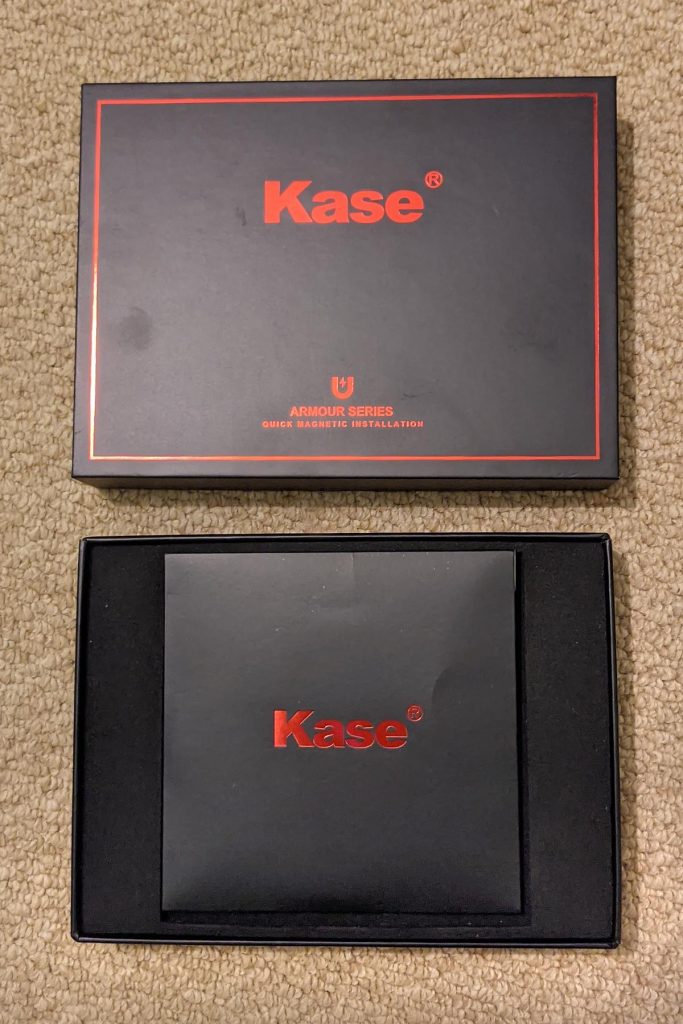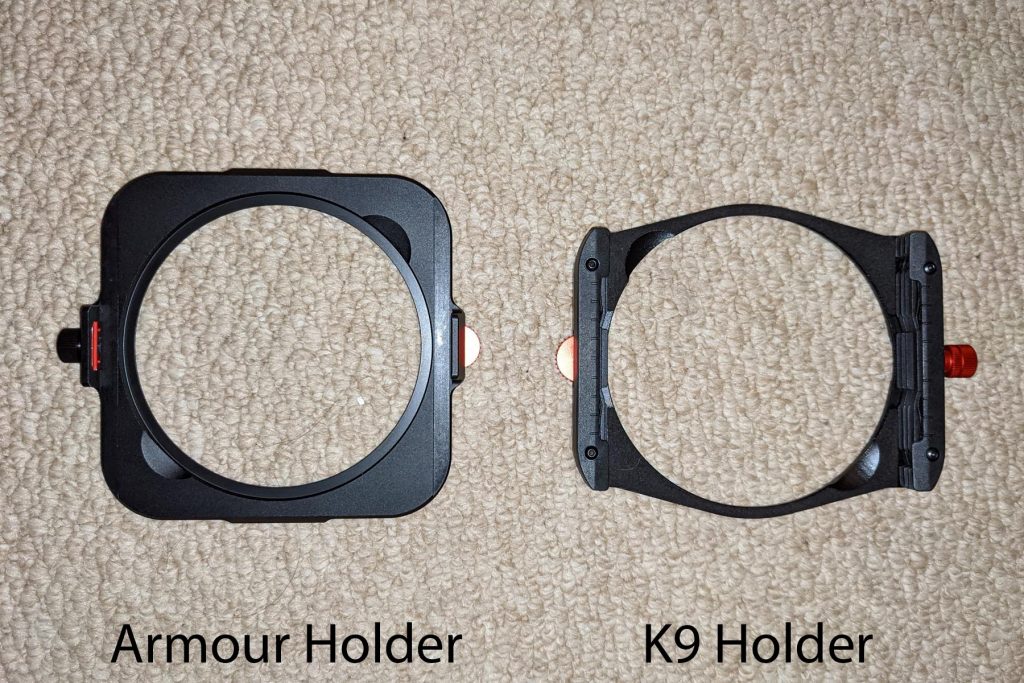Kase Armour Filter System Review by Kase UK Partner Nicky Goodfellow
Kase Armour Filter System Review by Kase UK Partner Nicky Goodfellow
In December 2021 I was very fortunate to be asked if I wanted to test the new Kase Armour system, which is the latest generation of holder, combining elements from the existing K9 100mm system and Wolverine Magnetic Circular filters.
I jumped at the chance! Having been a Kase filter user for a number of years, I am familiar with the products and currently use the brilliant K9 system, which features one magnetic element (the rear mounted polariser). I was intrigued at the concept of a fully magnetic system.
I was given the following equipment to test:
- Kase Armour filter holder
- Armour magnetic adapter rings x2 (77-95mm and 82-95mm)
- Standard (non magnetic) step rings x2 (67-77mm and 72-82mm)
- Armour Magnetic 95mm circular ND64 (6-stop) filter
- Armour Magnetic 95mm circular Polariser
- 1x 150x100mm and 1x 100x100mm Armour magnetic frames with hex key and spacing plates (these hold the standard 100mm Filters)
- Instruction leaflet


First Impressions
First impressions were excellent. The Armour filter holder quality is impressive. It is nicely finished and feels very robust (it is constructed of alloy).
The design has some similarities to the K9 holder in that it has a screw knob on one side (which secures the magnetic frames in place) and a scroll wheel on the other side (which allows the polariser to be positioned). Replacing the traditional guide rails are two magnetic plates which hold the frames in place. There is also a new addition of a spring-loaded clasp (buckle) which is used to secure/release the holder from the adapter ring.
The holder facilitates two magnetic circular filters (polariser and NDs) and two framed 100mm filters, four in total, which is the maximum number you would probably want to use. The beauty of the system is that any combination of filters can be used.
In terms of size, the Armour holder is slightly larger than the K9 holder, as the new Armour system accommodates a 95mm circular polariser, and use of 95mm Armour Circular ND filters. This means that any chance of vignetting is eliminated when used with an extreme wide-angle lens, such as a 14mm.
Although the holder is slightly larger, there is a negligible difference in weight.

Next out of the box, the magnetic circular ND and Polariser. These were surprisingly thin and light, but still felt solid in the hand.
Similar to the Kase Wolverine 100mm filters, they are made of high-quality toughened glass. They are deemed to be scratch resistant, water/dust repellent, and have virtually no colour cast.
There are several Armour kit options available for purchase, (a ‘holder’ kit and an ‘entry’ kit at the time of writing), and also options to purchase individual magnetic circular ND filters in different strengths such as the ND8 (3-stop) and ND64 (6-stop) ND1000 (10-stop). There is also the opportunity to purchase extra frames (should you require them).
Construction
The beauty of this system is that you can use your existing Kase 100mm filters. These require to be fitted inside the magnetic frames.
There is an instruction leaflet provided in the kit which provides a step-by-step guide to the process, which appears quite straightforward, but I also decided to watch the ‘You Tube’ demo video which was very helpful.
As I was only given two frames in the test kit, I had to decide which filters I wanted to frame. I chose two of my most used grads.
It is recommended that a maximum of two magnetic frames are attached to the holder at any one time, but should you desire you could frame up several of your filters so that they are easily interchangeable in the field.
Initial set-up was simple and only took a few minutes. As instructed, I laid the frame and filter on a soft cloth, loosened two of the screws on one side, gently pulled the frame apart slightly and slid the filter into the frame then tightened the screws back up. Et voila!
The filter felt quite secure in the frame.
I then attached the magnetic adapter rings onto the front of the lenses. These simply screw onto the filter threads.
Next I familiarised myself with the holder. It’s easy to remember which way it attaches to the lens as you can feel the raised ‘frame holder plates’ which face the front, and the release buckle faces towards the camera.
The holder simply attaches by the use of magnetic force with a satisfying clunk. No adjustments were necessary. It surprised me how quick it was to attach. It literally pulled out of my hands and on to the adapter ring. Dare I say it, but it was quicker to attach than the K9 holder.
Once the Armour holder is in place it is automatically secured to the adapter ring/lens by the spring-loaded buckle.
The magnetic circular filters (the ND and Polariser) attach to either side of the holder. These also attach very rapidly and lie nicely flush in the holder. This eliminates the chance of light leaks when undertaking long exposures. No foam baffle is required, yet another innovative design benefit of the system.
It is recommended that the polariser is attached to the rear of the holder, and the ND filter to the front.
This is so you can rotate the magnetic polariser, using the geared ring on the holder. Similar to the K9, you can use the magnetic polariser independently of the Armour holder. Although this is slightly more difficult to rotate in comparison.
Finally, the magnetic framed filters were attached to the front of the holder. These simply click on to the magnetic plates. This again was a quick and simple process although I found that it is important to ensure that the locking screw is fully unscrewed before the frames are attached so that the frames lie flush on the holder.
In the field
After familiarising myself with the system, I was eager to test in the field.
I tested the system on two lenses, a Nikon 24-70mm f2.8, and a 70-200mm f4, using a full frame Nikon D750 camera mounted onto a tripod.
As the polariser attaches to the back of the holder, I had to decide whether the scene warranted its use. I find the polariser particularly useful to cut through haze, and normally survey the scene directly though the filter to see the effect before confirming if it is required.
Assembly was quick and simple. The polariser was mounted in the rear of the holder and then the holder was attached to the adapter ring. The magnetic framed grad was then attached to the front, the positioning adjusted, and then a small turn of the locking screw and the frame was then locked into place. All of which was quick and simple. I was now ready to shoot.
The polariser is rotated via the use of the scroll wheel on the side of the holder and you can make minor adjustments very easily (even with gloves on). It rotates independently leaving the framed filters in their set position.
I found that the magnetic frames slide up and down very smoothly in the holder making it possible to make small adjustments very easily with just one finger (again, even with gloves on).
I did find that it was easier to attach the filters and adjust the positioning than when placed in the K9 holder which uses traditional guide rails.
Removal of the filters and holder is as swift as the connection. To remove the frames the locking screw just needs a small turn and then the frames can be pulled upwards and free of the holder. This literally took seconds.
The holder is also as quick to remove. The release buckle is pulled up slightly then the holder can be gently pulled off. Once you use the system a few times you develop your own technique of attaching/removing the holder and filters.

Conclusion
The landscape can be a harsh environment for camera equipment and you need a filter system which is robust, quick and easy to use, and most of all reliable.
I think the Armour system fulfils those requirements.
It is a very well-designed system, and it is evident Kase have engaged with photographers listening to their feedback, and have designed a product which is very much built for speed and is highly adaptable to cater for the needs of all.
The holder is well-designed, lightweight and robust, very quick to attach and works with ease. Once attached, it feels very secure.
The holder accommodates four filters in total, therefore the combinations are endless and can be tailored to suit every type of situation required from ‘simple’ 1 grad landscape shots, to more complex shots featuring numerous filter combinations.
The fact that you can use your existing Kase filters is a bonus, or any 2mm thick filters available on the market. You can purchase the ‘holder’ kit, then tailor the system, adding additional elements to suit your exact requirements.
The magnetic frames which surround the 100mm filters provide a welcome level of added protection. This can only be a good thing, especially when dealing with glass in the great outdoors where at some point in time a drop is inevitable. In fact once I completed the testing and removed the filters from the frames I felt a bit uneasy using them ‘un-armoured’ for the first time!
The system is specifically designed for speed, which is especially important when the light is rapidly changing and speed is of the essence… As we all know, when in the field every second counts.
The holder is quick to attach, and the framed grads simply click into place. No more lining up the grads into the guide rails.
One point to note however, is that in order to guarantee a speedy attachment you need to ensure that the locking screw is fully unscrewed before attempting to attach the framed filters, also to be aware that the circular filters only attach one way (the magnets will repel if fitted the wrong way round) so remembering which way they face is vital for quick assembly.
This did lose me some set-up time initially as I tried to attach the circular filters the wrong way.
I imagine that once you are proficient at using the system this will become second nature. Maybe something for Kase to look at in future production, having an ‘identifier’ such as a brightly coloured dot on the magnet side perhaps? Just a suggestion from my testing experience.
Also bear in mind that it IS a magnetic filter system, therefore the filters have the possibility of attaching to one another if placed together. I kept all the filters in separate pockets of my filter bag, so this was not an issue, but just a point to note when removing the filters in a hurry, not to place them on top of each other, or they may need to be pulled apart.
One final point to note, is that the system is slightly bulkier than the K9 system (larger holder and frames) but not by much and not necessarily heavier as the circular magnetic filters weigh less than the standard 100mm filters.
These points are certainly not in any manner criticisms of the system, just points that I found when using the system for the first time. However, I only had the system on test for a few weeks, and sadly sustained an ankle injury in that time, so my testing time was cut short, so I only managed to test the basics.
As with all systems, the more you use it, the more accustomed you will become using the holder, which will become second nature.
When I tested the K9 system some years ago I also found some ‘points to note’ but I quickly adapted (after switching from another Manufacturers system) and found the system covered all of my needs (and still does) and using it became second nature.
Would I recommend the Armour system? If you are looking for a good quality system which is highly adaptable, facilitates speedy attachment and ease of use and don’t mind the slight extra bulk, then yes, I would highly recommend!







